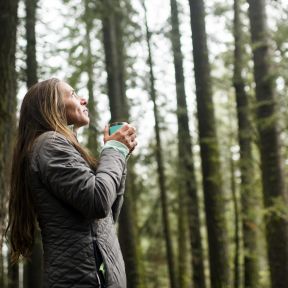
Forest Bathing
The Japanese Ministry of Agriculture, Forestry, and Fisheries coined the term shinrin-yoku or forest-bathing in 1982. Bathing in the forest, however, has nothing to do with water. The idea is to immerse yourself in a natural environment and soak up the many health benefits of being in the green woods. Forest bathing has been widely researched. One Japanese study that appeared in the International Journal of Environmental Research and Public Health examined 585 participants and found that urban dwellers are under a constant siege of stressors. Living in these conditions can leave people with increased physical and mental problems including depression, anxiety, and in some cases psychosis.
Across the continents, you will find forest bathing clubs and guides and tutorials. Forest bathing, also referred to as forest or nature therapy, has become popular in all corners of the developed world. The restorative nature of sitting in nature has been called soft fascination, whereby we are enraptured and uplifted by our surroundings. Forest bathing is an antidote to pinging distractions, impending deadlines, and never-ending obligations. Also, in one study that included images of natural environments, people felt more positive about their body image, which is the opposite of the self-disdain we may feel when scrolling through social media.
It appears that trees and plants do more than release oxygen and absorb carbon dioxide. In a study that appeared in the Environmental Health and Preventive Medicine Journal, researchers conducted field experiments in 24 forests in Japan. Half the participants entered the study environs and experienced a forest, the other half walked in an urban area. On the following day, the participants switched; half of them walked in and experienced an urban area, and the other half walked in and experienced the forest. The results showed that being in a forest environment, as opposed to an urban environment, lowered cortisol, pulse rate, and blood pressure. The forest also promoted greater parasympathetic nerve activity, and lower sympathetic nerve activity. As a result, their bodies became much more relaxed.
A study conducted by researchers at King’s College London, and published in the journal BioScience, found that participants in urban areas boosted their own well-being just by looking up at the sky, being exposed to trees and plants, and hearing birds chirp. These plusses stayed with the subjects for several hours after the exposure to nature.
Trees and plants emit phytoncides, essential oils that protect flora from parasites and germs. There are different types of phytoncides including alpha-pinene, beta-pinene, limonene, camphene, among others. These are natural antimicrobials that also benefit the human body; when we breathe in phytoncides, our bodies get a boost. Phytoncides increase natural killer cell activity and promote higher immunity. They work as anti-inflammatories that reduce oxidative stress, enhance sleep via alpha-pinene, reduce cortisol levels, and reduce blood glucose levels.
Alpha-pinene, or α-pinene, is a terpene or a class of hydrocarbons that occur mostly in plants and also in animals, like koalas. These compounds produce the smell of pines and evergreens and herbs, for example. Alpha-pinene is found in coniferous trees like pines, as well as in evergreen trees like eucalyptus. It is also found in herbs like frankincense, sage, rosemary, and ironwort. Beta-pinene, or b-pinene, can be found in plants like pleasant Himalayan mint and rhododendrons.
Both limonene and camphene are also terpenes. Limonene is found in vegetation like hemp, marijuana, and citrus fruits. Many herbs also contain this compound including rosemary, chamomile, ginger, and turmeric. Camphene is similar and found in chrysanthemums, cypress, camphor, citronella, ginger, valerian, and sage.
People in developed nations spend more time indoors and in front of screens, all of which lead to unhealthy lifestyles. However, time spent under the trees is supposed to be time spent without devices. Unhooking from the buzz of modern-day demands makes perfect and simple sense. Yet it is hard to do. And even if you leave your smartphone behind, shutting off the mind is difficult; the chatter inside the head can be ever-present. That is why you need to be mindful when spending time forest bathing.
Don’t bring the phone to tempt distractions. You need to empty your mind and be present with nature. When you are in the forest, walk slowly and look at the patterns of the leaves and the branches, take time to study the rock formations. Sit quietly and examine the colors around you, and listen to the birds, the wind, or just the silence. Remove your shoes and socks, so you can feel the soil between your toes. Use your senses to still your mind.
When you are anxious, your body takes shallow breaths and exhales too rapidly, which feeds your anxious state of threat with increased adrenaline and cortisol. Breathing slowly calms this anxiousness and the body retreats from its heightened awareness and defenses. Proper breathing from your diaphragm encourages full oxygen exchange.
According to a study in Scientific Reports, an open-access journal of Nature, just 120 minutes a week spent outdoors among the trees and plants can result in better health and overall wellness. This amounts to 15 or 20 minutes a day.
While some 85 percent of us live in suburban and urban areas, we can still get benefits by visiting a city park. The shades of green can calm you down. Humans prefer natural colors. In a 2016 study reported in Environmental Health Perspective, exposure to the color green was associated with longer life expectancy and improved mental health. In fact, people who live near greener areas have lower rates of mortality.
With our busy work and home schedules, getting to an urban park, let alone making a trek to the forest, can be difficult. Houseplants may not be an even match with either the forest or the park, but they can help. Plants do release oxygen and absorb carbon dioxide and have been found to boost mood and relieve stress.














